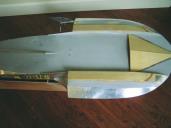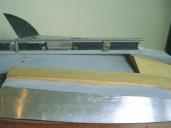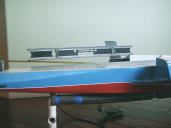






PROPWASH
16
April 2013
Scaling Up
(Continued from page 15)
The air rudder bracing is structural,
not just for looks. The turn fin attachment
especially needs strength. We ended up
with 1/16 aluminum outside and 3/16
aluminum inside the 1/8 inch plywood
sponson transom. The following pictures
show the bracket that holds the 3/16 heat
treated aluminum turn fin. Brian flipped
the boat at full speed while comfortably
in the lead in the final as a structural test.
(LOL and not his fault) The driver’s
helmet was all that was lost.
Engine and propeller choices are the
other part of the solution. We could have
run Brian’s 36 mm stroke, 30 mm stroke
rigger engine, but decided the more
conservative, high torque 36 x 29 engine
would be better. Both were seriously
modified. Probably the best out of the
box choice is the Quickdraw 29 cc
Pioneer. Quickdraw might be persuaded
to build a rear exhaust version.
Otherwise, the next choice would be the
M&D cast cylinder engine. It will
develop the power of the bigger engines
and can be run on an RCMK rear exhaust
case if that configuration is needed. At
this point, the side exhaust engines seem
to develop a little more power for no
obvious reason. I have no experience
with the 27cc CMB, 30cc RCMK, or
stroker engines using the M&D cast
cylinder, but they could be promising.
Thirty millimeter stroke modified
Zenoahs need longer rods and maybe oil
slots for their big end bearings to survive.
We ran a 1 inch header Beast pipe with a
modified stinger. I would run Quickdraw
pipes with Quickdraws and either
Quickdraw or M&D pipes with the M&D
cast cylinder engines.
Props need to be picked to suit the
engine/pipe combination. Brian favors
the new series ABC props. We ran a
modified 2716 2 blade with 10 degree rake. He felt the engine would pull even bigger
props, but we didn’t need more speed. In the past, I’ve run various Propworks 6717/3
props on my thunderboat. As with any new class, there will be a lot of testing before
the best solutions are found. It should be fun.
The $Bill Gas Scale with dummy motor
Look closely and you can see the bracing
tube for the rudder linkage
Observe the additional turn fin bracket
used to prevent bending in the turns
The turn fin bracket is bolted through the
hull for stability.
The bottom of the hull with ride pads
Checking the hull with air dam in place
Setting strut depth using a similar hull